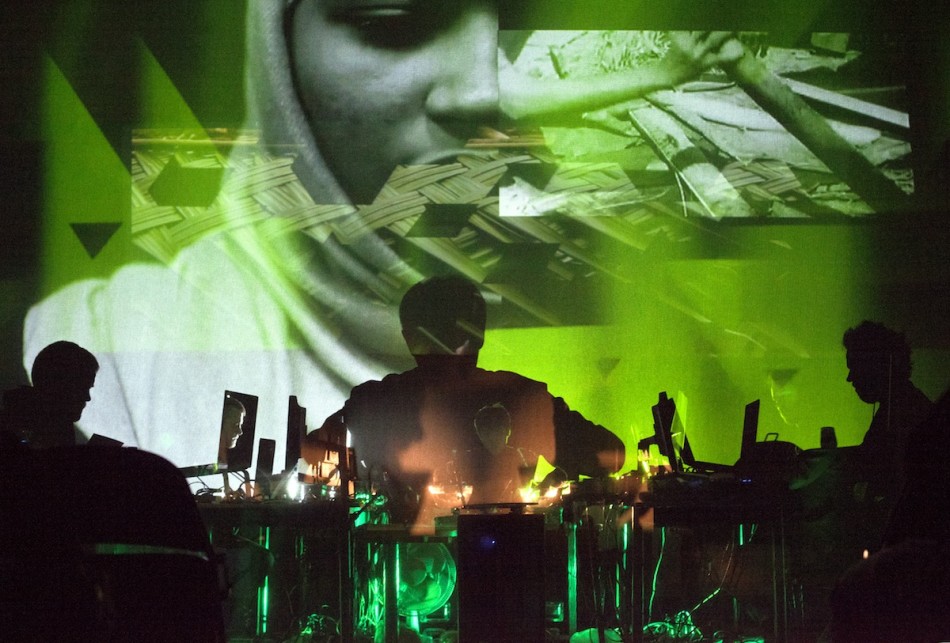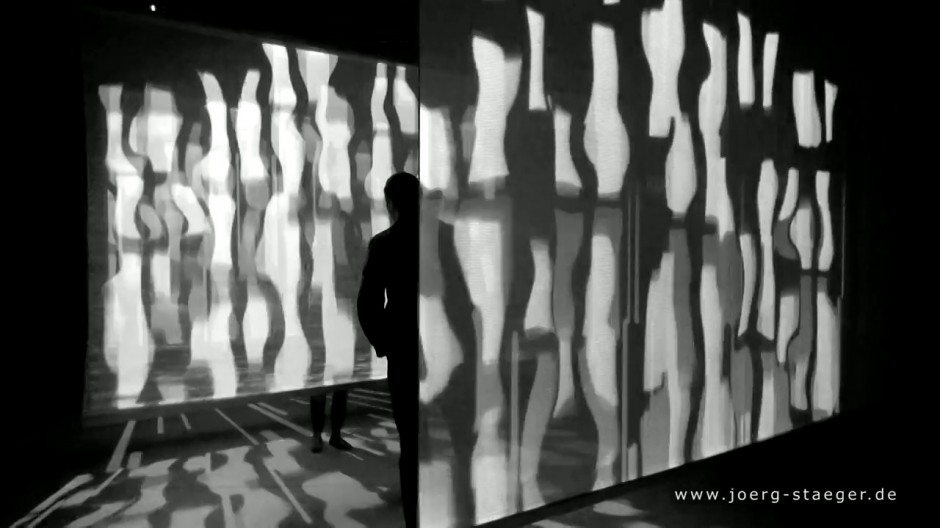
The Light Surgeons will perform SuperEverything at the Lensic on June 20th.
Reflections on the Public Space of CURRENTS New Media Festival
On the surface of CURRENTS new media festival, that’s what there is: surface. Surface flexes the critical joint of a festival full literally of viewing screens. The surfaces receive 2-D projections, but today viewers can walk around wearing Google Glass or other spymaster technology to trick our brains into 3-D seeing. Here’s a new, but old, saw: If I need a joystick to see better, what I see better make me care very deeply, given the fact that I left home or the studio to see this particular thing in the first place.
What in new media art today marks an equivalent to the question that was asked about Dan Flavin sculpture: is it still art when the light switch is turned off?
I pause for a second of irony, as I turn around inside El Museo Cultural de Santa Fe and briefly wonder what the letters LG blinking on the monitor mean — before realizing that LG is the brand displaying its chittering self-identification.
I reflect that I was always a reluctant video game player, preferring pinball to Pac-Man. My formative video-viewing at the Kitchen in high school incites a memory of frequently being bored but strangely gripped by leaf patterns on swimming pools and that flickering hum. Wow, bored — but then two hours had passed. My visceral recall goes also to a felt sense of trapped horror as Bruce Nauman’s tortured clown screams all through the halls of his retrospective in L.A. Then the chunky, oxygen-machine sound attending Bill Viola’s birth-death “Nantes Triptych” at St. John the Divine. Perhaps by then I was already tending my elderly mom, or else I just made that up, in the way that memory lies.
What happened between then and now is not only growing older and more satur-whelmed with images, but the sense that I don’t know what I’ve agreed to in coming to a video festival; is it spectacle or art that, by coming, I’ve agreed to see?
If I had my way I’d institute a few rules. Hold the mandalas. Ixnay to all video mandalas. Also: Hold the iPad. Ixnay to being asked to view on personal tablets in public space.
It’s hot. As I ponder, a woman sitting next to me says something out loud. Is she talking to me? She says, “I haven’t spent much time yet with this one.” I feel myself admiring her spirit of adventure in front of the work, her affirmation about spending time with inanimate things not requiring an answer.
CURRENTS new media festival is all of these moments — wow — plus irritation plus public space plus not-going-to-do-that plus a very immediate here-and-now-ness. It is ambitious and takes on a lot. Its reason for being is solid: That Santa Fe’s long history of video and new media innovation, via CURRENTS the festival, helps extend us, yes us HERE, into international relationships, with HERE being the nucleus of a widening circle.
Also, CURRENTS does great at community building, viz., new video work from students at a lot of schools, including Española Valley High, Desert Academy, the list goes on. A third thing: The festival has grown to include new doc film screenings as well as live concerts and performances. All to the good.
Here were the works this year that grabbed me such that I spent almost two hours at the show (with a disclaimer that I sadly missed Digital Dome Projections). They included:
“Egress” (and also “Swallowed Whole”) by Heidi Kumao. A narrative edge, particularly in “Egress,” about women’s relationships, both tenuous and physical, with banned books. A scissor cuts the kite a burkha’d woman is flying off an urban roof. The leaves of the pages rise and turn into tree leaves. Poetics.
Kayla Anderson’s “Beaming Baudrillard.” The artist made 3-D printed “furniture” pieces, like doll-house furniture, and invited us to come into the room. Compartments in the furniture become small screens for the video, as a red-dressed woman (the artist herself) makes something or frets over something or just stands around. I enjoyed how she brought me into her room, where she was all over and no place.
Ying Fang-Shen’s “Humanexus” was a stunning work of animation.
My favorite was Joerg Staeger’s “Milieu,” consisting of five screens which you could traverse and stand in between. It was co-titled “All I have is my Distance,” a phrase from Gilles Deleuze. Chunking, polishing, tapping sounds ran coevally with images that patterned static or other electronic forms in ways that put me back to very early encounters with Steina sea waves and air brakes. I could see my husband’s silhouette through one of the screens but, his figure over laced with the imagery and the sound, seemed so remote as to make him seem possibly unhuman. I thought this work was tremendous.
I had looked forward to the multimedia performance “Super Everything” by Light Surgeons, but a combination of jet lag and that persistent problem of screens and “What is spectacular?” prevented me from finding it interesting beyond the admittedly admirable high-production values of its images.
This goes to the question of what is spectacular. As an adjective, spectacular is a loose word — a spectacular sight like a star streaking across black sky; a glimpse of a horse running in a field — but as a noun, art-as-spectacle, the word and the concepts are more problematic.
This art-as-spectacle sets up a circular argument because, while you sat in the theater in the dark, you can’t be sure if it rained outside just by the blots of dust on the dry sidewalk when you emerge. It is possible it did. It is possible it didn’t.
 Circular arguments become provisional. In the case of “Super Everything,” their highly produced images (combined with jet lag) lulled me into a hypnotic state. Every time I jolted back in, it was a jolt to the tune of a talking head out of a National Geographic-style documentary opining on something I didn’t know why I was supposed to care about.
Circular arguments become provisional. In the case of “Super Everything,” their highly produced images (combined with jet lag) lulled me into a hypnotic state. Every time I jolted back in, it was a jolt to the tune of a talking head out of a National Geographic-style documentary opining on something I didn’t know why I was supposed to care about.
Meanwhile the layers of image kept moving: washing, in left, out right, up, down. Before the show began, I had heard an artist behind me ask a fellow artist what coding was.
The performers on the stage manipulating their theremins or engineering their soundtracks behind scrims embodied the disembodiment of the image, moving vaguely as passers of arcane knowledge amongst themselves. Real and not real, their stance toward their characters, much less the supposedly avant-garde audience that was us, was strangely enigmatic.
“Choice” can be a false freedom, as you might notice when you go on Netflix trying to decide which movie to watch. And art is a democracy and having these conversations is something that a festival like CURRENTS makes possible. Hear, hear!

Milieu: All I Have Is My Distance by Joerg Staeger

Egress by Heidi Kumao

Humanexus by Ying Fang-Shen
